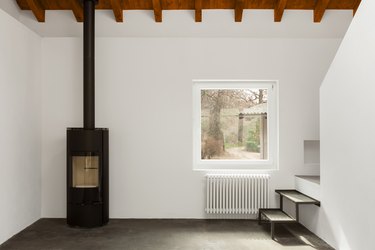
Heating your room with a pellet stove is an environmentally friendly option. If the pellet stove keeps going out, then it could be due to soot buildup. Consider the fuel source if the glass on the pellet stove gets cloudy quickly.
Benefits of a Pellet Stove
Video of the Day
Pellet stoves are energy efficient, with only 10 percent of heat being lost while operating, according to Energuide. A wood-burning stove can lose up to 50 percent of its heat.
Video of the Day
The blower system on a pellet stove provides an active smoke extraction system. The smoke rises through a thin tube, if necessary, so a special chimney doesn't need to be installed to make the pellet stove work well. There are three types of pellet stoves available to use:
- Stove — this is a manual loading pellet heater that does well for heating a room.
- Boiler — this can be used as the main source of heat for an entire building and the pellets are loaded automatically.
- Stove-Boiler — this hardworking heater warms the room while also providing hot water for a radiator.
Importance of Pellets
The grade of the fuel used in the pellet stove along with how often it is used will determine how often the appliance's glass needs to be cleaned. The fuel in the pellet stove is the base of the soot issue and, therefore, needs to be carefully chosen and used. Ideally, the pellets you choose to use should leave as little ash and clinker residue as possible and heat the space efficiently.
Some pellets can cause more soot than other brands of heating pellets, according to Home Tips. Pellets that are higher in price typically burn hotter and cleaner than those on the lower end of the price spectrum. Test out different brands of pellets to find one that works well with your needs and specific pellet stove. Pellet stoves that are top-fed generally require a higher grade of pellet. Bottom-fed stoves can handle a lesser quality pellet, but these may create a bigger pile of ash to clean.
Pellet Stove Glass Is Cloudy
Performing regular maintenance will keep the appliance in good working order all year long. If the pellet stove glass is cloudy, then it can impede your ability to check the fire's progress and any issues. Use a pellet stove glass cleaner on the glass front after each use or at least once a week to keep soot from building up on the panes.
Use an ash vacuum to remove ash quickly and easily. This also cuts down on having to clean up any spilled ash or allowing the ash to spread into the air with each scrape and scoop of the grimy pile of spent pellets. Clean out the ash trap or drawer once a week if the pellet stove is used daily to cut down on cloudy glass issues. While cleaning out the ash trap, look for soot buildup on the surfaces of the stove that you can see. Clean soot off of the metal surfaces with a wire brush.
When to Call a Professional
It's a good idea to have the pellet stove and chimney inspected by a professional once a year, preferably before the heating season gets underway. A professional can clean the stove's flue and ensure that the chimney is securely in place.